01 August 2021, 21:36
Michael RobinsonBOTSWANA – 2021 - PHIL SMYTHE MEMORIAL CAPE BUFFALO SAFARI REPORT
BOTSWANA – 2021 - PHIL SMYTHE MEMORIAL CAPE BUFFALO SAFARI REPORTOutfitter: Thys de Vries, of Trophy Quest Botswana, in affiliation with Jacques Hartzenberg and Jumbo Moore, of Chapungu – Kambako Safaris
Booking Agent: None. Booked directly with Jumbo Moore and Thys de Vries and his wife, Merilyn de Vries.
Airlines: Qatar Airways and SA Airlink
Travel Agent: Steve Turner, TWG
Location: CH 8 Hunting Concession, Chobe District, Northeastern Botswana
Duration: 12 days
Professional Hunter: Thys de Vries
Rifles: (1) AHR Custom CZ 550 Magnum, Caliber .450 Rigby and (2) AHR Custom CZ 550 Magnum, Caliber .500 A-Square, each with a Leupold FX-II 2.5x20mm scope mounted in Talley quick-detachable CZ ring mounts.
Game Taken: Two Cape buffalo
Game Sought But Not Taken: None
BACKGROUND
As many AR members know, Phil Smythe, a young Zimbabwean professional hunter, was mauled and killed late last year by an elephant while hunting the huge beasts in the Save Valley Conservancy in his native country.
Through a raffle for a Cape buffalo hunt donated by Thys de Vries, of Trophy Quest Botswana, in affiliation with Jacques Hartzenberg and Jumbo Moore, of Chapungu – Kambako Safaris, and organized by our own Larry Shores, close to $30,000 was raised for the benefit of the Smythe family.
My name was selected as the raffle winner (in a second-go-round, after the original winner indicated he was unable to go). I immediately contacted Jumbo Moore and arranged with Jumbo and Thys to increase the length of the safari from the original seven days to twelve, add a second Cape buffalo to the bag limit, and confirm that my wife would be an observer.
Like all of us in the African hunting community, I’m grateful to Thys, Jumbo and Jacques for donating this hunt, to Larry Shores for generously organizing the entire effort, and to our host Saeed for promoting it through this excellent website. They have all contributed to ease the pain of a suffering family, and are to be commended for doing so.
My wife and I wish peace and good will to Phil’s wife and family during these hard times and in the years ahead. Although I never had the pleasure of meeting Phil, the many tributes we have all seen to his life and work speak volumes about the positive impact this fine young man had on all of those who were lucky enough to know him.
AIRLINES
We had no problems with our airlines or with travel from Boston through Doha and Johannesburg to Kasane, Botswana. All of our bags, including my rifles and ammunition, were checked through from Boston to Kasane and made the trip with no difficulties.
We did not have to claim our luggage at JNB on either our inbound or outbound flights. We had VIP assistance and obtained a SAPS permit, just in case, but did not need the permit. The VIP service helped us to by-pass long lines at immigration and security both ways.
My ammunition remained in a locked case in our checked luggage all the way to Botswana and back.
I simply filled in and signed the required paperwork at check in and showed my 4457s. All in all, having my own rifles and ammunition with me added an hour and a half or so to the process in Boston and Kasane, and less in Johannesburg and Doha.
Well worth it, in my opinion. My guess is that flying business class helped, as we were shown deference and given priority by Qatar at every turn.
A final note – Qatar business class flat out wins the airline competition. Best comfort, convenience and service we have ever experienced, with Emirates coming in a close second, and Turkish a not too distant third.
COVID 19
First and foremost, on the subject of COVID 19, my wife and I have both been vaccinated. Each of us got the Pfizer vaccine in March of this year. We would not travel these days without that protection.
As for our trip, apart from having to build in time at both ends for taking and getting the (negative) results of PCR tests (in each case in less than 24 hours), COVID 19 was not a factor. The private lab in Kazungula, Botswana even emailed our results to us.
Our test results were examined on the way to Botswana only upon departure from Boston and arrival in Kasane, and again upon departure from Kasane at the end of our trip. No one in Johannesburg or Doha, in transit, asked to see them, and no one in Boston, upon our return, did so either. Our sense is that we were not “special” – it seemed to us that everyone on our planes got the same treatment.
As a destination, Botswana is a bit different, in that, upon arrival, before passing through customs, the health officials require that four or five different health forms be filled out and submitted, after which they administer a rapid antigen COVID 19 test to all arriving passengers. Everyone on our plane tested negative (which was not surprising, since all of us had had a negative PCR test within the past 72 hours).
On the way back home, SA Airlink charged me US$40 in handling fees for each of my rifles, but that was no surprise, as TWG had advised me that those fees would be payable upon departure.
Masks must be worn at airports and on airplanes, and everywhere in Botswana, but let’s just say that those requirements are relaxed in business class, in hotels and in the bush.
Many thanks to Steve Turner and his team for their excellent planning and advice regarding requirements relating to the airlines and COVID 19.
PROFESSIONAL HUNTER
Zimbabwe native, and long-time hunter in Botswana and Zimbabwe, Thys de Vries, would be our PH on this trip.

Thys also owns and operates Lodzi Hunters in Zimbabwe, with operations located in Binga, on the shores of Lake Kariba, and also in the CAMPFIRE area Tsholotsho South, bordering Hwange National Park. Thys is one of the most experienced professional hunters, and in particular, elephant hunters, on the continent.
Thys and his son, Christopher, who is a PH in training, were great hosts in every way.
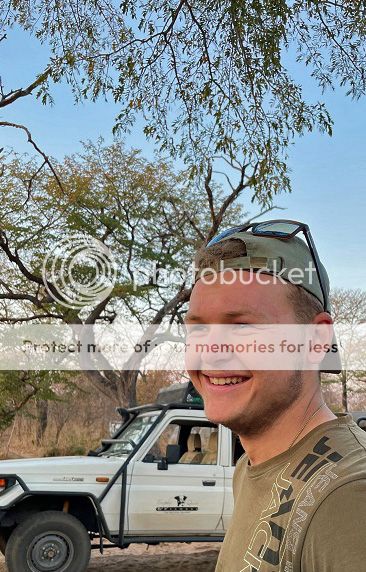
HUNTING TEAM
Daniel, who used to hunt with Thys prior to the recent Botswana hunting ban, and who re-joined him when it was lifted, led our team of trackers. Kenneth, a San bushman and the eldest of the group, was quiet and effective. Our third tracker, Mbeya, was the youngest, and did more than hold his own.
Daniel
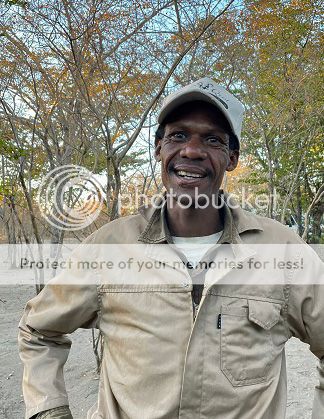
Kenneth
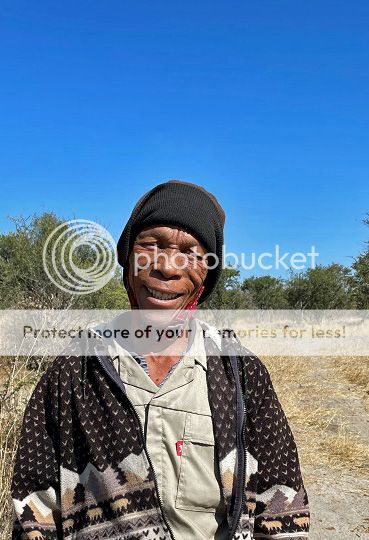
Mbeya
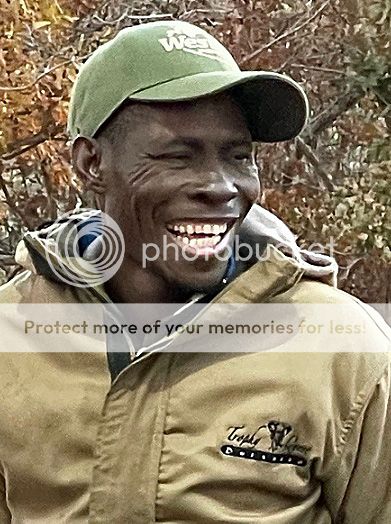
Without truly excellent trackers, the kind of hunting we did would have been impossible. Ours were more than up to the task, and we were and are grateful for their tireless help every step of the way.
CAMP
Our hunting camp, in the CH 8 Hunting Concession, was about a 2-3 hour drive south from Kasane International Airport. Our tent was large and comfortable. It included full, en suite, plumbing facilities, with fresh hot and cold running well water, good electricity and Wi-Fi and excellent and bright fluorescent lighting.
We had a comfortable shower every evening, before enjoying sundowners by the fire followed by suppers in the large and comfortable dining tent.
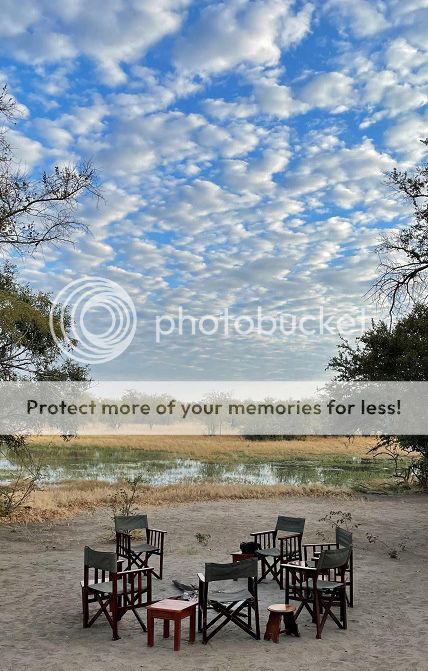
We especially appreciated the warm fires.

It is cold in northern Botswana in July. Very cold. Nights were spent with hot water bottles under piles of blankets. Warm, well-insulated outer clothing was essential during the days, except in the early to mid-afternoons, when the sun would begin to have a warming effect.
My wife found comfort in the back of Thys’s double cab Land Cruiser only by swaddling herself in a large, thick blanket!
After we arrived in camp, we checked the zeroes on my rifles. By firing one shot from each, I confirmed that both were still right on target – in the black at about 80 yards. I was using my hand loaded ammunition using Barnes TSX bullets.
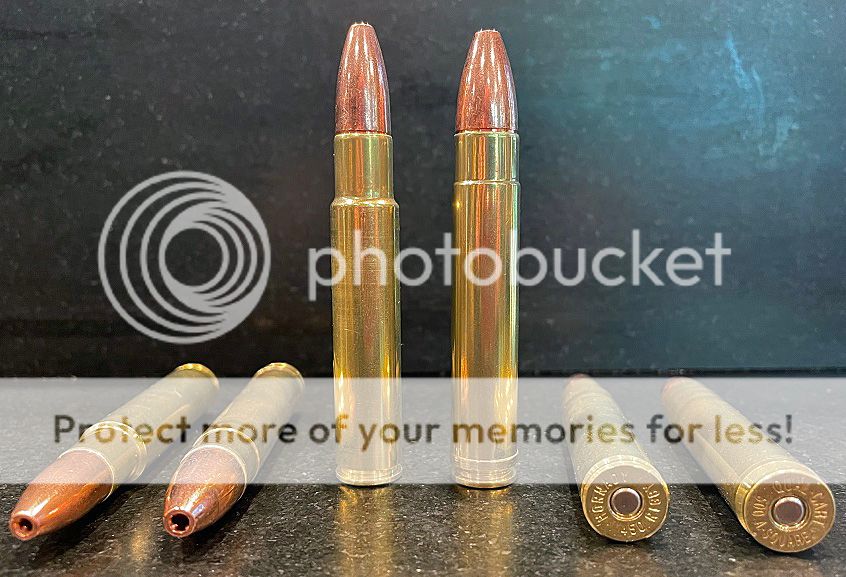
More on my load development and final loads can be found here: Share Your Favorite .450 Rigby Loads
We saw thousands of birds, as well as other flora and fauna, including sable, zebra, impala, kudu, warthogs, jackals, common duikers, steinbock, roan, a huge tree monitor and even a puff adder who was leisurely crossing one of the cut lines that act as fire breaks on some of the concession boundaries.
In addition, we saw a great deal of elephant spoor, and lots of elephants. Calm, large and extremely huntable elephants.
We did not take a lot of photos, as we were hunting for Cape buffalo exclusively and intensively, but here are some examples. (I apologize for the quality of some of them, as they were shot in a hurry with phone cameras in some cases.)
Crimson Breasted Shrike

Largest Mopane Tree I Have Ever Seen
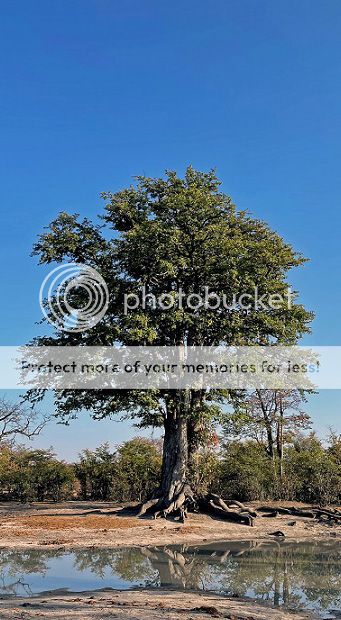
Big Elephant
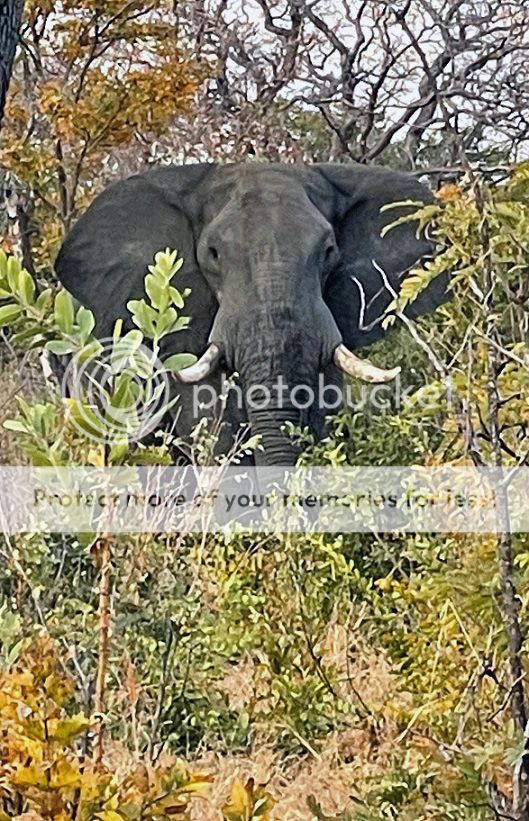
Large Tree Monitor

Puff Adder
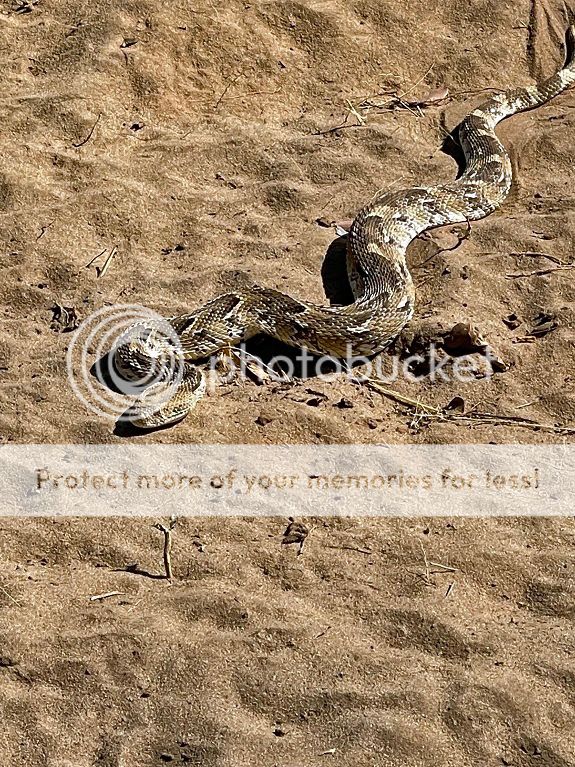
CAPE BUFFALO HUNTING
I love to hunt buffalo. Thys told me that CH 8 had herds of them, sometimes numbering in the hundreds, but that they were not resident herds. They wandered through the concession, sometimes staying for a while, but always moving on.
A German hunter on the previous safari had shot an 80+ pound elephant and had also shot a good buff out of a herd. He had apparently used up all of our luck, at least as far as buff in herds were concerned.
We saw no herds during our nine days of hunting. Instead, we had to search for old dugga boys. I prefer to hunt old, isolated dugga boys. They are past their prime, beyond breeding, and always have enormous character and toughness.
So, we looked for fresh tracks near the pans, or waterholes, spread throughout the concession. When we found a fresh track, we would follow it up, either right then and there, or the next day, depending on when the track was made and when we found it.
We had no luck for the first couple of days. We would find good spoor and follow it, often for many hours, only to lose the buff, or simply never make up any ground. The terrain was thick mopane scrub or grassland. How our trackers stayed on these buff was utterly beyond me.
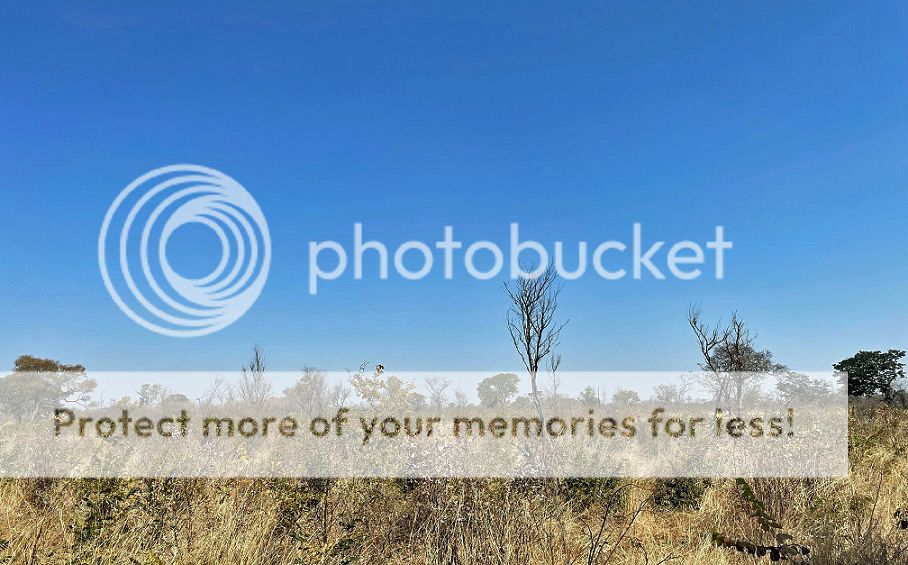
I would watch them work. If they lost the track, which I sometimes could not see in the first place, they would spread out and look until they once again picked it up. It was sometimes slow going, but at other times, when the buff had followed a well-established game trail, it was a double time march down the path. We were always trying to make up ground, and catch the buff feeding or lying down.
Our treks lasted from a few to several hours, and covered from a few to more than ten miles. It was tough, not to say grueling, and challenging for all concerned.
FIRST BUFF
Finally, on the third day, we caught up with a pair of dugga boys after about four hours of stalking. Thanks to a well-placed dead tree that Daniel was able to climb, he spotted the bulls we had been stalking about fifty yards ahead of us, lying down in the grass of an open field, completely at ease and unaware.
It had been so cold the previous night and that morning, that the bulls had decided to nap in the sunlight.
We stalked undetected to within about 30 yards of them. I could see only the horns of the nearest buff, just above the grass. They looked good.
Thys put up the shooting sticks, just to the left of a small tree, and I put up my .450. Then we began waiting. We knew the bull was going to get up at some point, and that then I would have a clear broadside shot.
We waited for about a half hour or so, then adopted a new tactic. Thys and the trackers began throwing sticks into the grass near the bull. It took four sticks, but suddenly, after the last stick hit in the grass in front of the bull, he stood up, alert and alarmed.
I instantly shot him in the left shoulder. He spun 180 degrees and began running. I got out of the sticks and tried to track him for a second shot, but the tree got in my way. I maneuvered around the tree to my right just as Thys said, “He’s coming our way! Shoot him!”
The buff had turned toward us – I’m sure by chance – and then stopped running and faced us with his head up. He stared at us, with blood streaming from his nose, about twenty yards away.
I quickly raised my rifle and shot him in the forehead, just above his right eye. He dropped like the proverbial ton of bricks.
After we walked up to him, I put two finishers into his brisket, and he was deader than Nando’s fried chicken.

We recovered two of the Barnes TSX bullets from his body. The other two, including the one I shot into his forehead, were pass-throughs.
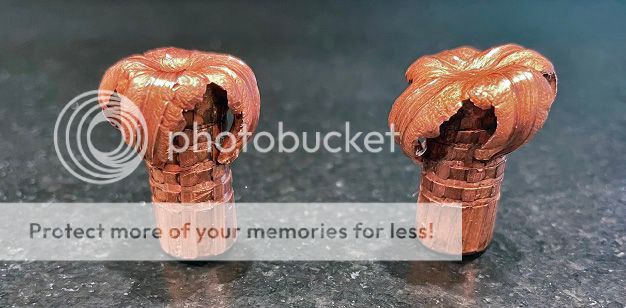
This was a very boring and slow hunt, until things got exciting in a hurry, which is typical of buffalo hunting! The team really clicked on this one, all up and down the line. I was very happy with this old dugga boy.

SECOND BUFF
It wasn’t until the ninth day of hunting, six days after we took the first bull, that we tracked down the second.
This one and a partner had left tracks in the middle of the night at another pan. The tracks headed off into the bush. We followed, early the next morning.
After about three hours of quiet tracking, Daniel spotted the bulls off to our right, no more than fifteen yards away! The wind was good, and they were calm, with no clue that we were stalking them.
Thys put up the sticks, looked through his binocular, and whispered that I should shoot the lead bull. All I could see was his shoulder, through a gap in the shrubs, and I was lining up my .500, when Thys whispered to wait, that the second buff was bigger.
But then Thys got a better look at the trailing buff, and pronounced him too young.
We moved the sticks a couple of yards, and again I lined up the shot, but I couldn’t tell if the younger bull was behind the one I wanted. Thys whispered that he was clear, and I put a 570 grain Barnes TSX bullet into the old bull’s shoulder.
He hunched forward less than five yards, and I quickly shot him three more times. That was it. He stumbled and fell down for the count, and then bawled out his death knell.
This was a truly old buffalo. He was grey-faced, with a worn-down boss and a rump clawed by lions, and was blind in his right eye.
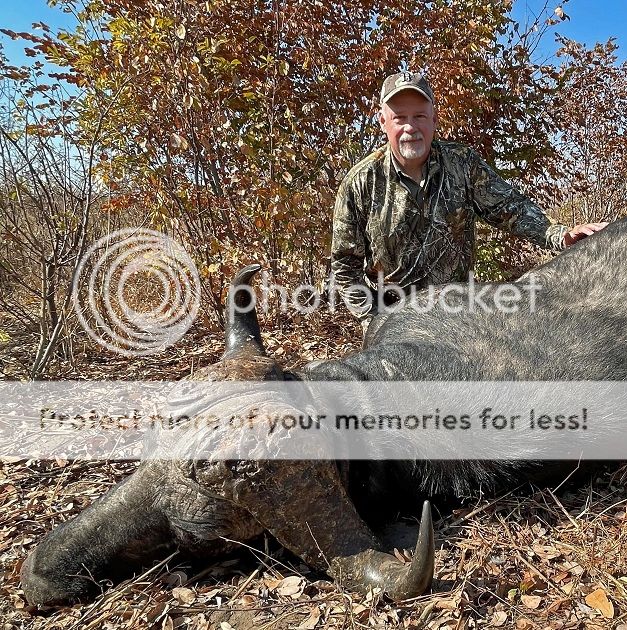
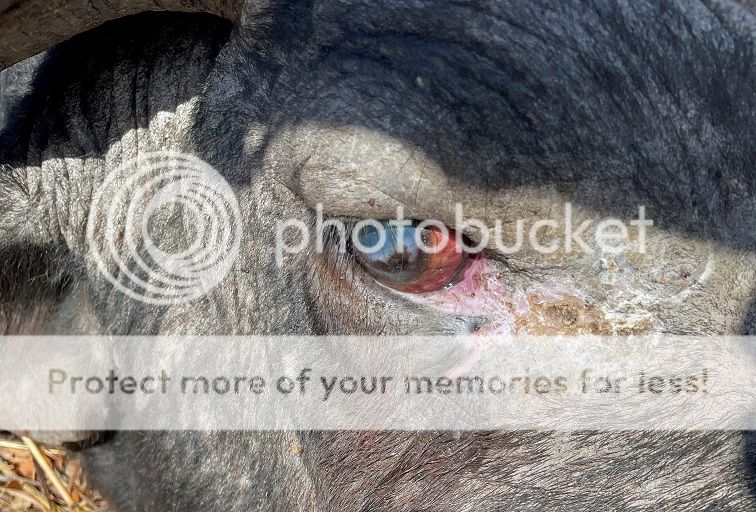
All of my bullets completely penetrated the bull’s body. 570 grain, .510 caliber Barnes TSX bullets at just south of 2,500 fps and impacting at fifteen yards will do that!
This is all we found – a couple of broken petals in a wound channel. All the rest are still in Botswana.
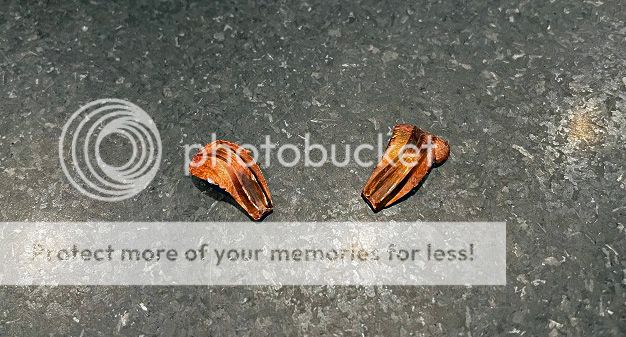
CONCLUSION
This safari tried and tested me physically. The long days spent tracking led to many blisters and more foot pain than I have ever suffered. Part of that is because I am no longer a spring chicken, I am sure. More like an old rooster these days.
My wife (who was right in the thick of it on every stalk) and I both had to be alert to dehydration, and drink copious amounts of water throughout each day.
But success heals all wounds.
Thys, as is his deal with the local communities, gave the meat from both of my Cape buffalo to the chiefs of local villages, for distribution to the people. I am happy that we provided needed protein for diets that generally lack it.
I am also happy that we made a success out of this hunt in tribute to another hard hunter, Phil Smythe, and for the benefit of his family.
Also, I would be remiss if I did not express our thanks to Merilyn de Vries for her help in arranging this safari, and also for helping us to plan an impromptu stay at the Eagle Island Lodge in the middle of the Okavango Delta, at our safari’s early end.
For those of you wanting to hunt in Botswana for dangerous game, I can confirm that Botswana is wild and ready. I can also highly recommend it, and Trophy Quest Botswana in particular.
I hope that this report has been enjoyable and helpful. It has been a lot of fun to write it.